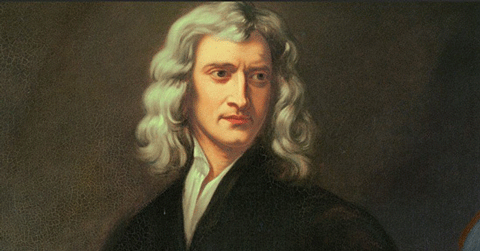At Principia's heart were Newton's three laws of motion (which state, very baldly, that a thing moves in the direction in which it is pushed; that it will keep moving in a straight line until some other force acts to slow or deflect it; and that every action has an opposite and equal reaction) and his universal law of gravitation. This states that every object in the universe exerts a tug on every other. It may not seem like it, but as you sit here now you are pulling everything around you—walls, ceiling, lamp, pet cat—toward you with your own little (indeed, very little) gravitational field. And these things are also pulling on you.
《原理》的核心是牛頓的三大運動定律(定律非常明確地指出,物體朝著推力的方向運動;它始終做直線運動,直到某種別的力起了作用,使它慢下來或改變它的方向;每個作用都有相等的反作用)以及他的萬有引力定律。這說明,宇宙里的每個物體都吸引每個別的物體。這似乎不大可能,但當你在這里坐著的時候,你在用你自己小小的(的確很小)引力場吸引你周圍的一切事物--墻壁、天花板、燈、寵物貓。而這些東西也在吸引你。

It was Newton who realized that the pull of any two objects is, to quote Feynman again, "proportional to the mass of each and varies inversely as the square of the distance between them." Put another way, if you double the distance between two objects, the attraction between them becomes four times weaker. This can be expressed with the formula F = Gmm/R^2 which is of course way beyond anything that most of us could make practical use of, but at least we can appreciate that it is elegantly compact. A couple of brief multiplications, a simple division, and, bingo, you know your gravitational position wherever you go. It was the first really universal law of nature ever propounded by a human mind, which is why Newton is regarded with such universal esteem.
是牛頓認識到,任何兩個物體的引力,再用費曼的話來說,“與每個物體的質量成正比,以兩者之間距離的平方反比來變化”。換一種說法,要是你將兩個物體之間的距離翻一番,兩者之間的引力就弱4倍。這可以用下面的公式來表示: F=Gmm/(R^2) 這個公式對我們大多數人來說當然是根本沒有實際用途的,但至少我們欣賞它的優美,它的簡潔。無論你走到哪里,只要做兩個快速的乘法,一個簡單的除法,嘿,你就知道你的引力狀況。這是人類提出的第一個真正有普遍意義的自然定律,也是牛頓到處深受人們尊敬的原因。











